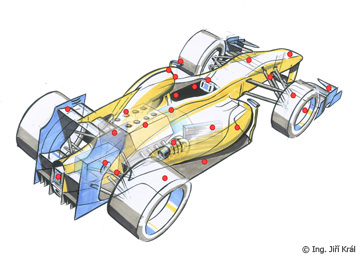Pedal to the Metal in Monza Haas F1 Team Seeks Seventh Straight Points-Paying Performance
Mike Arning/HAAS F1 | 28.8.18 | Aktuality
HAAS F1 2018
Pedal to the Metal in Monza, Haas F1 Team Seeks Seventh , Straight Points-Paying Performance.
KANNAPOLIS, North Carolina (Aug. 28, 2018) – The summer shutdown came and went, and Haas F1 Team’s performance never skipped a beat.
After scoring a double-points finish in the July 29 Hungarian Grand Prix prior to the three-week break mandated by the FIA, Haas F1 Team picked up right where it left off by scoring another double-points finish on Sunday in the Belgian Grand Prix. It was the American squad’s third double-points result this season, but its first back-to-back double-points finish in the team’s still young history.
In fact, Haas F1 Team has finished in the points six straight times to rise to fifth in the constructors’ standings, where it is just six points behind fourth-place Renault with a healthy 24-point advantage over sixth-place McLaren.
Now, the fastest track on the 2018 FIA Formula One World Championship schedule beckons – the Autodromo Nazionale Monza, home of the Italian Grand Prix. Haas F1 Team will keep the pedal to the metal at the 5.793-kilometer (3.6-mile), 11-turn circuit in the suburbs of Milan, where two long straights are separated by a few chicanes and some wide, sweeping corners.
These characteristics allow teams to bring a low-downforce package where their drivers are able to approach speeds of nearly 350 kph (217 mph) to earn an average lap speed in excess of 250 kph (155 mph). In fact, the fastest lap ever recorded in Formula One took place at Monza.
Juan Pablo Montoya holds the record and the bragging rights at Monza, with his lap of 1:19.525 in his Williams BMW set during practice for the 2004 Italian Grand Prix delivering an average speed of 262.242 kph (162.950 mph). This came during the height of the V10 engine era, where seven suppliers – Ferrari, Mercedes, Honda, Renault, BMW, Toyota and Ford-Cosworth – engaged in an arms race where peak power output was approximately 940 horsepower with RPMs in excess of 19,000.
Engines only had to last a single race in that time, whereas now teams are limited to using three engines a year. But the march of time and technology means that in 2018 the all-time fastest lap in Formula One history might be in jeopardy.
At every venue Formula One has visited in 2018 except Baku City Circuit and the recently added Circuit Paul Ricard, the track record has been broken.
Monza has hosted Formula One since 1950, with this year’s Italian Grand Prix serving as the venue’s 68th grand prix. The average winning speed in the first Italian Grand Prix was 176.55 kph (109.7 mph). Last year’s was 243.627 kph (151.383 mph). As Formula One technology has advanced, its display of speed has been most impressive at Monza, where the track has earned the moniker, Temple of Speed.
Despite today’s Formula One cars being outfitted with turbocharged 1.6-liter V6 engines, engineers have wrung considerable power from these tightly packaged units. And thanks to an aerodynamic and tire package introduced last year that has increased downforce and corner speeds, lap times have dropped substantially. Case in point: the fastest lap in last year’s Italian Grand Prix – a 1:23.361 at 250.174 kph (155.451 mph) set by Red Bull’s Daniel Ricciardo – was more than two seconds better than the fastest lap from the 2016 Italian Grand Prix.
The rub, however, is that these current-generation Formula One cars are not as fast in a straight line, as their increased downforce creates increased drag. It’s in the corners where these cars shine.
Monza has 11 turns, which means that despite its long straights, there is speed to be found. Can Montoya’s 14-year-old mark survive this inevitable evolution of Formula One? Time will literally tell.
As the sport has evolved greatly over its 68-year history, Haas F1 Team has evolved greatly in its barely three-year history.
After scoring 29 points in 2016 and 47 points in 2017, the American team has already surpassed both of those tallies 13 races into its third season. Drivers Romain Grosjean and Kevin Magnussen have combined for 76 points with still eight races remaining.
Haas F1 Team’s evolution has been aided by its partnerships with Ferrari and Dallara, where the two companies provide critical motorsports expertise in addition to some Italian lineage.
Maranello-based Ferrari delivers Haas F1 Team its power unit, gearbox and overall technical support, and famed racecar builder Dallara has Haas F1 Team’s design staff embedded in its Parma headquarters.
This unique relationship allowed Haas F1 Team to hit the ground running in 2016. The massive task of creating a Formula One team from scratch was made slightly less daunting by the more than 130 collective years of racing experience brought by Ferrari and Dallara. The partnership has matured since, with Haas F1 Team’s current point tally providing the best testimonial.




